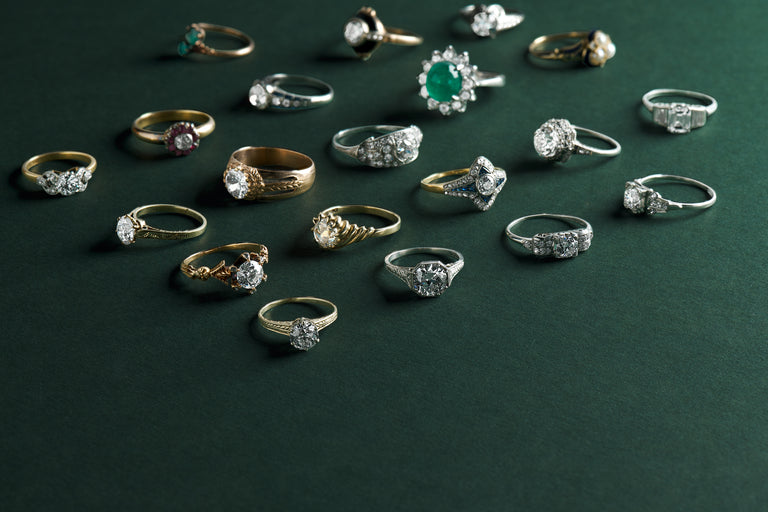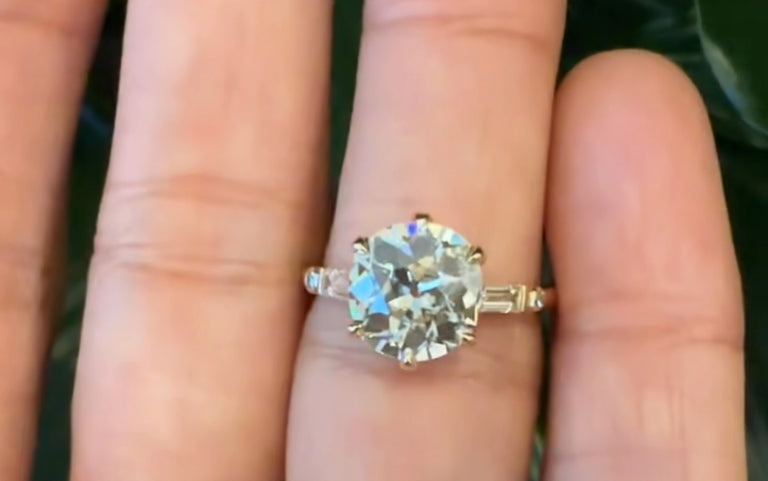Explore the beauty of old European cut diamonds. These vintage gems from the 19th and early 20th centuries have a unique facet pattern that sets them apart from modern cuts. Their rich history make them a sought-after choice for both modern and vintage engagement rings.
Key Takeaways
-
Look for Distinctive Features: When searching for old European cut diamonds, pay attention to their unique characteristics like smaller tables, larger facets, high crowns and open culets.
-
Understand the Differences: Differentiate between old European and modern cuts by considering factors such as cut, color and clarity but don't overlook overall appearance to make an informed choice.
-
Consider Pros and Cons: Evaluate the pros, like rarity and uniqueness, against the cons, such as less brilliance, possibly more warmth and imperfections, before purchasing old European cut diamonds.
-
Seek Expert Guidance: When buying old European cut diamonds, seek advice from reputable jewelers who specialize in antique diamonds to ensure authenticity and quality.
-
Explore Vintage Options: Explore antique and vintage engagement rings featuring old European cuts or consider a modern setting featuring an antique stone if you're looking for a new meets old look and want a brand new ring.
-
Maintain Carefully: To preserve the beauty of your old European cut diamond, follow proper maintenance practices like regular cleaning and professional inspections to keep it in top condition.
What Are Old European Cut Diamonds
Emergence
Old European cut diamonds originated in 19th century Europe, characterized by a unique at the time, round shape. This style marked a significant shift in diamond cutting techniques. Prior cuts included rose and old mine cuts.
Key Features of Old European Cuts
These diamonds stand out for their round shape, small table, high crown, and open culet. The facets are larger compared to modern cuts, giving them a distinctive sparkle.
Distinctive Shape
Old European cut diamonds are renowned for their distinctive shape that sets them apart from modern cuts.
Smaller Table Size
One key feature of old European cut diamonds is their smaller table size, which refers to the flat top facet of the diamond as compared to modern diamonds. This smaller table size impacts the overall shape of the diamond which sometimes gives it a chunkier appearance.
Historical Significance
Old European cut diamonds played a crucial role in the evolution of diamond cutting. They were a bridge between earlier cuts like the Old Mine Cut and modern brilliant cuts.
Comparing Old European and Modern Cuts

Shape Differences and Evolution of Cutting Techniques
Old European cut diamonds typically have the same 58 facets as modern round brilliant diamonds. However, there are significant differences in how those facets are proportioned and arranged:
-
Faceting Style: While both cuts have 58 facets, Old European cuts tend to have larger, more uneven facets, which results in a softer, less sparkly light reflection compared to the sharp brilliance of modern cuts.
-
Crown and Pavilion Angles: Old European cuts have steeper crown angles and deeper pavilions, which alters how light reflects and disperses within the stone.
-
Table and Culet: Old European cuts have a smaller table (the flat top facet) and a larger, open culet (the flat facet at the bottom), both of which further differentiate their light performance from modern brilliants, which have a pointed or very tiny culet and a larger table.
So while both have 58 facets, their light performance and visual characteristics are quite different. The Old European cut offers a more romantic, subdued brilliance, while the modern round brilliant is optimized for maximum sparkle and fire.
The cutting techniques for old European diamonds were manual and relied heavily on the artistry of the cutter. In contrast, modern cuts benefit from advanced technology such as computer-aided design (CAD) and laser cutting.
Old European cuts were hand-cut with basic tools like a wheel or a copper disc coated with diamond dust therefor each old European cut diamond tends to differ from the next.
Advantages and Disadvantages of Old European Cuts
Forever Timeless
Old European cut diamonds boast a timeless look that captures the essence of the era from which they came. The style of old European cuts, with their distinctive facets and larger culet, sets them apart from modern cuts. Despite changes in cutting techniques over the years, old European cuts have stood the test of time.
Brilliance and Rarity
However, one potential drawback of old European cuts is their less brilliance compared to modern cuts. Due to their deeper pavilions and smaller tables, these diamonds may not exhibit the same level of sparkle as modern diamonds.
In addition to differences in brilliance, old European cut diamonds are also known for their rarity. As these cuts were popular during the late 19th and early 20th centuries, finding high-quality old European diamonds can be challenging. Their scarcity contributes to their popularity but also means that they may come at a higher cost compared to more readily available modern cuts.
Tips for Buying Old European Cut Diamonds
Researching Specialists
When considering old European cut diamonds, it is crucial to research reputable jewelers who specialize in these antique gems. Seek out experts with a proven track record in dealing with vintage diamonds to ensure authenticity and quality.
Assessing Clarity and Color
Inspecting the diamond for clarity and color is essential, as these factors significantly impact its value. Look for stones with minimal imperfections and a color that complements the overall aesthetics of the piece.
Evaluating Craftsmanship and Setting
When purchasing an old European cut diamond, it's vital to consider the overall look of the diamond as each is quite different and unique. Pay attention to the intricacy of the design of the setting, the quality of the metalwork, and how well the diamond is showcased within the setting.
Antique and Vintage Engagement Rings with Old European Cuts
Popularity of Old European Cuts
Old European cut diamonds are probably the most popular diamond cut within antique and vintage engagement rings. Dating back to the late 19th and early 20th centuries, the antique old European cut diamond was the only round shape of its kind available during the Victorian, Edwardian and Early Art Deco periods.
Newly Made Rings with Antique Old European Cuts
Modern Craftsmanship
Modern jewelers are increasingly incorporating antique diamonds like the old European cut diamond into newly made rings. These rings often feature vintage style settings.
The Erstwhile collection celebrates the unique beauty of antique diamond cuts like the Old European cut. Settings—such as the Prism Shifter, Leia, and Classic Solitaires—are designed to accentuate the beauty of each individual stone. Blending antique inspiration with modern craftsmanship, each piece is thoughtfully handcrafted to perfectly match its diamond.
Customization Options
Due to the one-of-a-kind nature of antique and vintage engagement rings once a piece sells they are no longer available and buyers will sometimes seek to recreate a setting just like it.
They can opt for a jeweler who specializes in antique recreations to create a personalized piece that is a perfect recreation of the original including the antique diamond itself. These artisans offer a range of customization options, from selecting the antique diamond to customizing the setting with a different metal than the original vintage design. For example recreating an originally platinum Art Deco setting in 18k yellow gold, creating a truly original piece.
Maintaining Your Old European Cut Diamond
Regular Cleaning
To maintain the sparkle of your old European cut diamond, clean it regularly. Use a mild solution of warm water and gentle dish soap. Gently scrub the diamond with a soft-bristled brush to remove dirt and oils that can dull its shine.
Remember to avoid harsh chemicals or abrasive materials that can damage the diamond's surface. After cleaning, rinse the diamond thoroughly with clean water and dry it with a soft, lint-free cloth to prevent water spots.
Professional Inspections
Schedule yearly professional inspections for your old European cut diamond ring. A jeweler can check for any damage to your setting that may affect the diamond's security in the mounting and reinforce prongs as needed.
Safe Storage Practices
Use safe storage practices to protect your old European cut diamond from scratches. When not wearing your diamond, store it in a soft pouch or lined jewelry box to prevent it from coming into contact with other hard surfaces.
Frequently Asked Questions
What are Old European cut diamonds?
Old European cut diamonds are antique diamond cuts popular in the late 19th and early 20th centuries. They have a unique facet pattern with a small table, high crown, and open culet, giving them a distinctive sparkle.
What are the key features of Old European cut diamonds?
Key features of Old European cut diamonds include a round shape, high crown, small table, deep pavilion, and large faceting. These features contribute to their romantic and antique feel.
How do Old European cuts compare to modern diamond cuts?
Old European cuts differ from modern cuts in their facet pattern and proportions. Modern cuts like the round brilliant have more facets for enhanced brilliance, while Old European cuts have larger facets for a warmer glow and chunkier overall look.
What are the advantages and disadvantages of Old European cut diamonds?
Advantages of Old European cuts include their unique look and rarity. However, they may lack the fire and brilliance of modern cuts. Finding well-preserved and high quality Old European cut diamonds can be challenging.
How do I choose an Old European cut diamond when buying one?
When buying an Old European cut diamond, consider the same factors as you would with a modern diamond like cut quality, color, clarity, and carat weight. However remember that each antique old European cut diamond is quite unique and special onto itself so lean more on your intuition and the look of the overall diamond rather than these very precise scientific measurements. Look for reputable jewelers specializing in antique diamonds.
Are Old European cut diamonds as valuable as modern diamonds?
Old European-cut diamonds are highly sought after by collectors and connoisseurs. Their rarity and historical significance contribute to their premium prices in the market. The value of old European cut diamonds is determined by the same factors as modern diamonds like the four C's - cut, clarity, color, and carat weight - playing a crucial role in assessing their quality and price. When it comes to cut, old European cut diamonds are distinguished by their distinctive and unique shapes and faceting styles which is often different stone to stone. So the individual value of old European cut diamonds really comes down to each stone. This is why you want to work with an antique diamond expert to help guide you to the right stone within your price range.



